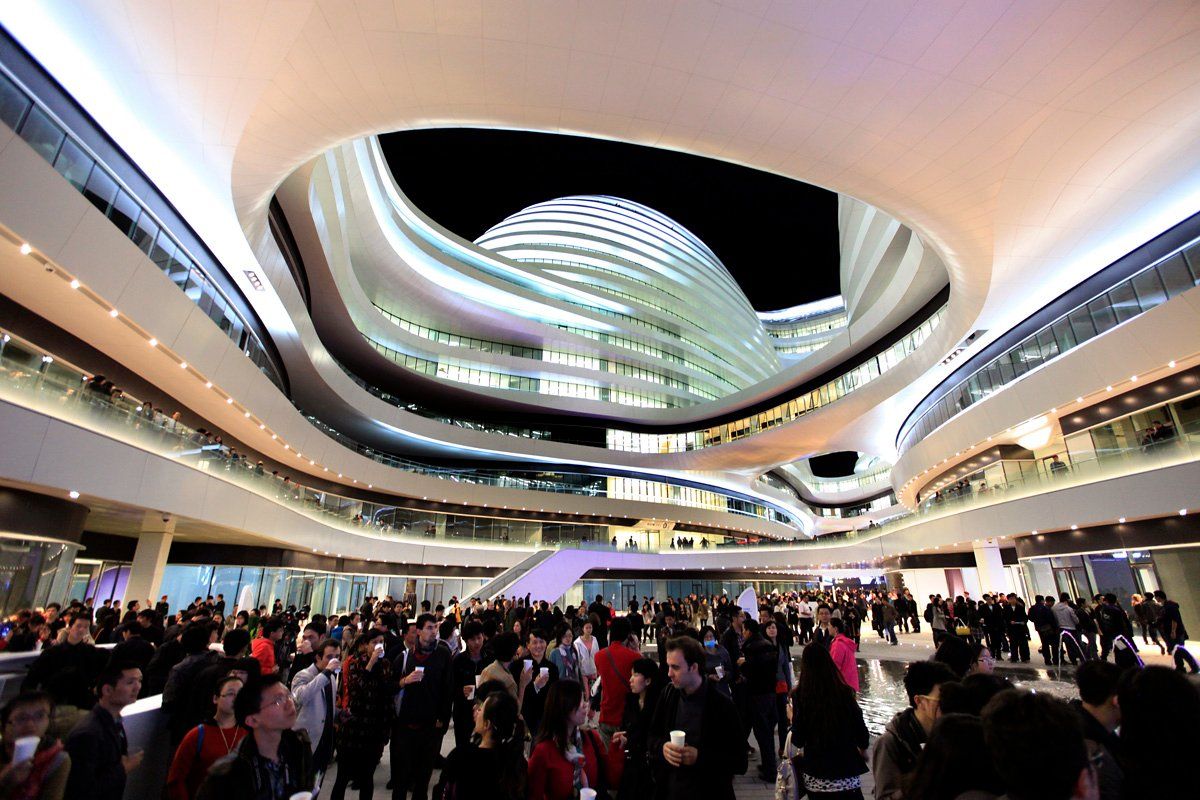
With the benefit of hindsight, Iraqi-British architect Zaha Hadid's story about her first visit to China sounds like a tale of destiny. In 1981, China was just awakening from its paranoid Maoist slumber and opening up to the outside world. Hadid was fascinated. She bought every color of Mao suit available (black, charcoal grey, green, blue). The cities were dark and drab, but she said it was a "very, very important trip." She traveled by train to various towns and met Chinese who'd never seen foreigners before. "I bought Walkman tapes, and Chinese borrowed them to listen to at night," she told Newsweek during a recent trip to Beijing. "Even then I thought, 'You could do a lot of building here.'"
And since then, she has. As dusk fell on a crisp October day, thousands of well-wishers converged on Beijing's second ring road, jamming traffic and thronging what had been for several years a vast construction site. Everyone jostled to catch a glimpse of the architect and her boldest project yet—a futuristic development called Galaxy SOHO. "A few days ago we tweeted news about the project's completion and invited people to sign up for the opening," said Zhang Xin, CEO and cofounder of SOHO China, which built the project. "Fifteen thousand people tweeted back, saying they wanted to come." When Hadid and Zhang entered a central atrium to greet fans, a stampede nearly broke out as everyone surged to take cellphone photos.
Even by Beijing standards, the surrealistic project—with its bulging, organic shapes and mesmerizing curves—is an eye-opener. Without the high-tech computerized design methods developed over the last decade, said SOHO China cofounder Pan Shiyi (Zhang's husband), "you simply couldn't do this. Over here, every piece of glass is different. Over there, each strip of aluminum is not the same." China-based architect Antonio Ochoa says the project's "fluidity is unique," while U.S. ambassador Gary Locke declared it "just like the Starship Enterprise." As if the building's sinuous, swooping lines weren't otherworldly enough, female staff hired for the opening celebration wore white Star Trek—style outfits with iridescent wigs in fuchsia, violet, and lime green. "I first came to Beijing more than 30 years ago," Hadid told the adoring crowd. "We always thought we could do something amazing here. Now is the right time, and this is the right place."
By now you'd think Beijing would be blasé about bold buildings and foreign architects, who've been making regular pilgrimages to China's capital for more than a decade. The city hosts some of the most cutting—edge buildings on the planet. Rem Koolhaas's firm OMA worked on the gravity-defying CCTV headquarters, which locals have dubbed the "Giant Boxer Shorts." During the 2008 Olympics, viewers thrilled at the steel-entangled "Bird's Nest" National Stadium, designed by Herzog & de Meuron. Just beside Tiananmen Square sits the titanium-and-glass National Grand Theater designed by Paul Andreu, which came in way over budget at close to $500 million. But within that constellation of stars, at least in Chinese eyes, Hadid is a white-hot supernova.
"No one's a bigger draw than Zaha," said Zhang, whose firm is involved in two other projects with Hadid. "More of her firm's projects are in China than in any other single country." China and Hadid seem to be a natural fit. In 1994 Hadid designed a radical opera house for Cardiff in Wales, but red tape prevented it from being built. In 2011 when the stunning black granite-and-glass Guangzhou Opera House, designed by Hadid's firm, opened to praise, many commented that this was the opera house that Britain could have had.
Hadid thinks big; China wants big. "Every country has its local requirements. In China, the requirement is to be big. Where else can you get this scale?" said Zhang, making a sweeping gesture that nonetheless failed to take in Galaxy's entire 330,000 square-meter-footprint. "That's its Chineseness." (It also helps that property developers have been able to buy large chunks of land, relocating entire neighborhoods.) For Satoshi Ohashi, project director of Galaxy SOHO, one of the enduring memories of the project's early days occurred in March 2009. "We'd just finished the schematic design… then Zhang came and said, 'Can you just add on another 29,000 square meters to this building?' We had to go back and add another 29,000 square meters."
With that much space, Hadid's challenge was "to find a new way to create a large mass and then break it up. Like taking a rock and starting to carve it, with strata and contour lines… like a mountain range. It was refreshing." She compares Galaxy to a valley surrounded by a series of mountains—and then she laughs, recalling that once upon a time "for many years, I hated nature. As a student I refused to put a plant anywhere—a living plant, that is. Dead plants were OK." But then came her seminal trip to China. For a month she tramped through public parks mingling with masses wearing Mao suits. She says she visited every garden in Suzhou, a genteel city near Shanghai renowned since imperial times for its meticulously designed parks. "The gardens were full of people. Their apartments might have been small, but the parks were open, in the public domain. After visiting China, I liked nature."
Indeed, onlookers say there's something subliminally "Chinese" about the Guangzhou Opera House and Galaxy SOHO, especially the way they evoke water and land forms. "Zaha has stressed the importance of the construction being part of nature," says Beijing-based architect Zhu Pei. Even the language her firm uses to describe Galaxy evokes nature: its four domed masses "coalesce and fuse, pull apart and connect, via bridges and plateaus." Retail units surround a central "canyon." There's no question that the 2004 winner of the Pritzker Architecture Prize (tantamount to a Nobel for architects) has left her mark on China's landscape. The secret of her success here may have something to do with the fact that China also left its mark on Hadid.
Uncommon Knowledge
Newsweek is committed to challenging conventional wisdom and finding connections in the search for common ground.
Newsweek is committed to challenging conventional wisdom and finding connections in the search for common ground.
About the writer
To read how Newsweek uses AI as a newsroom tool, Click here.





